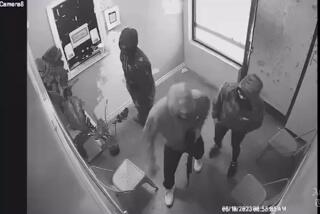Rat Patrol
- Share via
The cat is out of the bag about the stealth campaign to save the carnations in the Los Angeles flower district.
The popular mainstay of girls’ bouquets and guys’ boutonnieres was becoming a main course for rodents that sneaked into sprawling floral markets in downtown L.A.
“The rats like the little seeds in carnations. We’d see petals all over the floor in the refrigerator and know they’d come in to eat,” said grower Philip Sandoval, who sells blossoms at the Southern California Flower Market.
But the flower district turned to a four-legged security patrol to put an end to the refrigerator raids.
Not guard dogs. Guard cats.
“The rats were scary. Somebody would scream, and you’d see a big black thing run by,” said Deb Hector, a flower buyer for Gelson’s Markets who purchases truckloads of blooms each week.
“They weren’t afraid of people--they would come out and look you right in the eye. We’d tried poison, traps, sticky glue stuff. Nothing worked,” said Scott Yamabe, general manager of the 89-year-old Southern California Flower Market.
“Then we tried feral cats,” he said. “And the rats disappeared almost overnight.”
Three cats have been put to work at Yamabe’s warehouse-size floral center at 755 S. Wall St. Impressed by the results, operators of the Los Angeles Flower Market across the street have put six cats on duty there, including two more last week.
“I was skeptical at first--I’m a dog kind of guy,” said Johnny Mellano, general manager of the Los Angeles Flower Market.
“Rats eat carnations. They like red and yellow ones the best, because there’s more sugar in them,” he said. “We’d been fighting them for years. We had an exterminator come in once a week and spread powder around. But they were in coolers, everywhere.”
The guard cats were the idea of Melya Kaplan, founder and executive director of an animal rescue group called Venice Animal Allies.
Kaplan shops in the district every Friday for flowers for her Venice home. On one shopping trip two years ago, she noticed a worker having a coughing fit.
“He said he was reacting to the spraying they were doing for rats. I went to the market people and told them they wouldn’t have to spray if they had cats,” she said. “I think they thought I was a little loony--it took a while to get them to agree to try it.”
Since feral “alley cats” are generally afraid of people, Kaplan’s group picked them for petal patrol duty. The first group was bailed out of an animal shelter, neutered and then taken to the flower district. There, they were “colonized”--kept for several weeks in cages in a dark corner of a market building until they became comfortable with the sights, sounds and smells of the place.
These days they hide out during the flower marts’ normal 2 a.m.-to-noon business hours. In the afternoons and evenings, when the warehouses are closed, they emerge to patrol the empty floors and flower stalls.
“We never see the cats. But one of our vendors was watching a TV surveillance monitor and actually saw one corner a rat. The rat moved to one side and the cat followed. The rat moved again and so did the cat. It didn’t get away,” Mellano said.
The cats don’t eat the rats, Kaplan said. Instead, rats are routed from the flower marts by the scent of the felines. “You rarely see a dead rat. If you do, you won’t see bite marks. The rat was likely scared to death,” she joked.
Nonetheless, flower mart workers who tend to the cats’ food, water and litter boxes say they are careful not to overindulge the animals.
“At first we fed them too much, and they got fat and lazy and slept all the time,” Mellano said.
Across the street, Southern California Flower Market staff member Carl Jones agreed. “If a cat ain’t hungry, he ain’t gonna hunt,” he said.
More to Read
Sign up for Essential California
The most important California stories and recommendations in your inbox every morning.
You may occasionally receive promotional content from the Los Angeles Times.











